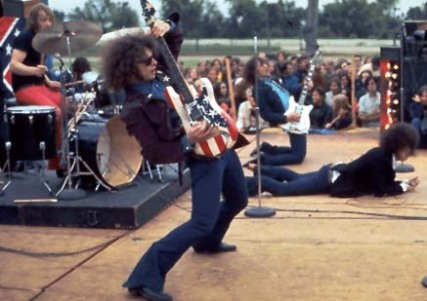One of the perks of living in Key West for several years back in the early 90s was celebrity-watching. I once saw Madonna enter a helicopter on top of a yacht and fly about 100 yards to a chopper pad on a condo building so she wouldn’t have to ride in a dinghy. I once had a drink with Tommy “Tutone” Heath and spent a lost weekend with James Taylor’s doomed brother Alex (who made a great album “Graveyard Dogs”). I even helped Cher and Richie Sambora tie off a rental yacht they were using. But the best celebrities in the Keys usually live there and may not even be considered real celebrities by some measures. Brother Wayne Kramer was one of these.
As some of you know Wayne was the afro-permed guitarist (along with Fred “Sonic” Smith) of MC5, the Detroit proto-punk rabble-rousers who were the house band for the White Panther Party. The three albums they made (Kick Out The Jams, High Time and Back In The USA) didn’t make a huge dent in the record charts, and MC5 didn’t have a very long or particularly successful career but their influence was incalculable. Their combination of deafening hard-rock and radical politics foreshadowed the punk movement by nearly a decade. I was in the second grade about the time they hit their peak so I didn’t hear it until much later. I was introduced to them by a Blue Oyster Cult cover of “Kick Out The Jams.”
One of my slacker jobs in the Keys was renting scooters to tourists at the Hyatt where Wayne’s wife Margie also worked. It came up during lunch one day that she was married to THE real Wayne Kramer from MC5. I was sensibly skeptical so Margie invited me over to meet him. I didn’t really recognize him from the 70’s era pictures I’d seen; he was a pale, skinny unassuming guy with a fierce mien and intense demeanor. He seemed surprised that I knew who he was and we had a good conversation about the early Detroit rock scene, The Stooges, his friendship with Iggy Pop, his “Gangwar” project with the late Johnny Thunders and his stint in federal prison for selling cocaine to an undercover officer. He was working as a carpenter (detailed in his spoken-word track from The Hard Stuff called “Incident on Stock Island”) at the time and was shopping some songs around to some small labels. These songs would become the album Death Tongue. Wayne sent me home with a cassette of Death Tongue as well as Gangwar and a wiggy Mick Farren collaboration called “Who Shot You Dutch?”. I also got an invitation to see The Wayne Kramer Group perform on Halloween at the Key West institution The Green Parrot.
The Wayne Kramer Group was really Wayne playing guitar with local reggae favorites The Survivors, only this was no reggae concert. I pulled up a corner bar seat and got a Stoli screwdriver and then witnessed nearly three hours of the most unforgettably intense and furious hard rock guitar clinics I’ve ever seen. Kramer’s Stratocaster whined, snarled and barked in a feedback-drenched pastiche that had my ears ringing and my eyes popping. All I remember thinking was how much this guy needed a bigger stage. The Parrot fully loaded held maybe 100 people that night. I thought he should be selling out stadiums.
I brought Wayne a drink out at intermission. He was leaning against a rusty old Buick on the curb sweating profusely with his hands on his knees. All I could say was “wow” and Margie said “See? I told you. Still got it.”
The halloween gig at The Parrot was a regular thing for a few years, then like a lot of us do Wayne drifted away from Key West. I found my way home to Missouri late in 1994 and while shopping in a record store in Springfield I came across Wayne’s Epitaph Records debut The Hard Stuff. The record was everything I expected and more, and I got a big chuckle when I heard Margie on the rhyming intro to “Pillar of Fire.” It was cool to read liner notes written by Henry Rollins that captured Kramer’s intense and precisely manic style. The follow-up Dangerous Madness appeared soon after, and then the epic Citizen Wayne. Kramer ascended to his rightful place as one of the godfathers of punk, widely recognized and revered for his musical accomplishments and his support of social causes. He was even recognized as number 92 of Rolling Stone’s Top 100 Guitarists of All Time.
Wayne apparently has a big fan in comedian Will Ferrell who tapped him to score his hit movie Talladega Nights, and Wayne’s song Edge of the Switchblade appears on the soundtrack. He continues to score films and record his music a long way off from that cabinet shop he was working in on Stock Island. To me Wayne is an object lesson in perseverance. After prison he could have chucked it all and kept on working at carpentry, especially in that fallow period in the eighties where it seemed no one wanted to hear what he had to say or play. He stuck to his guns and came out blazing on the other side. True talent like Wayne’s can’t be dimmed or hidden for long. Do yourself a favor and pick up an MC5 or Wayne Kramer album today.

March 10th, 2015 at 8:44 am
Somehow for no reason at all ‘Incident On Stock Island’ popped into my head and while looking up info on it I came across this. Killer! Very envious right now, haha!! Really enjoyed the read.